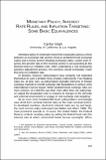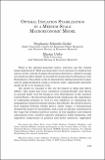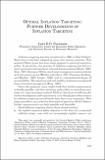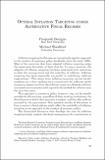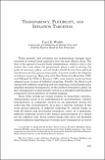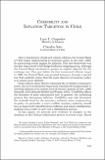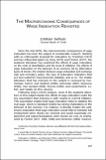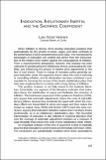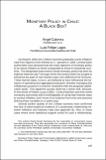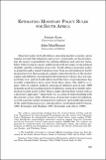Search
Now showing items 61-70 of 79
Monetary policy, interest rate rules, and inflation targeting: some basic equivalences
Monetary policy in small open economies is typically cast as a choice between an exchange rate anchor (fixed or predetermined exchange rates) and a money anchor (floating exchange rates). Under such regimes, the growth rate of the nominal anchor is set according to the desired long-run inflation rate. ...
Optimal inflation stabilization in a medium-scale macroeconomic model
What is the optimal monetary policy, and how can the central bank implement it? Both questions have been extensively studied, but always in the context of simple theoretical structures, which by design are limited in their ability to account for actual observed business cycle fluctuations. This article ...
Optimal inflation targeting: further developments of inflation targeting
Inflation targeting was first introduced in 1990, in New Zealand. Since then it has been adopted by more than twenty countries. This period of fifteen years has seen major progress in practical monetary policy. In particular, the practice of inflation targeting has led to a more systematic and consistent ...
Optimal inflation targeting under alternative fiscal regimes
Inflation targeting has become an increasingly popular approach to the conduct of monetary policy worldwide since the early 1990s. Most of the countries that have adopted inflation targeting judge the experiment favorably, at least thus far. In many countries, the adoption of inflation targeting has ...
Transparency, flexibility, and inflation targeting
Three parallel and certainly not independent changes have occurred in central bank practices over the past fifteen years. The first is the spread of central bank independence, which is tied to the notion that even when the government plays a role in setting the goals of monetary policy, central banks ...
Credibility and inflation targeting in Chile
After a long history of high and volatile inflation, the Central Bank of Chile began implementing its monetary policy in the early 1990s by announcing yearly targets for inflation. This new framework was the first step toward a full-fledged inflation-targeting setup, although the Central Bank continued ...
The macroeconomic conseguences of wage indexation revisited
Since the mid-1970s, the macroeconomic consequences of wage indexation has been the subject of considerable research. Starting with an enthusiastic proposal for indexation by Friedman (1974) and two influential papers by Gray (1976) and Fischer (1977), the academic literature has examined the effects ...
Indexation, inflationary inertia, and the sacrifice coeficient
When inflation is chronic, firms develop indexation practices that automatically tie the growth of prices, wages, and other contracts to the performance of some comprehensive price index. The microeconomic advantages of indexation are evident and derive from the immunization of the relative price ...
Monetary policy in Chile: a black box?
During the 1990s the Chilean economy gradually cut its inflation rate from figures in the thirties to 4.7 percent in 1998. Central bank authorities have declared that the main objective of monetary policy is to reduce inflation to levels comparableto those in industrial countries. The desgnated ...
Estimating monetary policy rules for South Africa
Monetary policy in South Africa's emerging market economy, given capital account liberalization and severe constraints on fiscal policy, has the major responsability for curbing inflation and currency instability while trying to ensure sufficient growth for longer-term political stability and the ...

